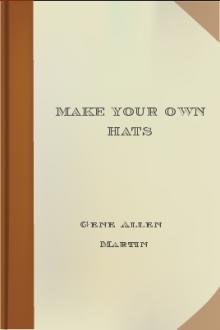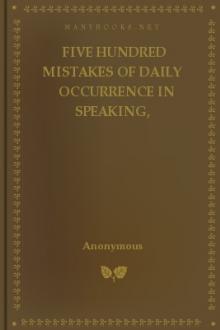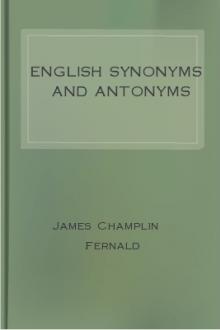Make Your Own Hats, Gene Allen Martin [ebook offline txt] 📗

- Author: Gene Allen Martin
- Performer: -
Book online «Make Your Own Hats, Gene Allen Martin [ebook offline txt] 📗». Author Gene Allen Martin
To cover with braid—
Great care and patience must be exercised in covering a hat with straw braid. The lines which are to be emphasized should be carefully studied, as there are several methods used in laying the braid on the frames. (See illustration.)
The stitch used for sewing braid is always the same—a very short stitch on the right side, and a stitch one-quarter of an inch long on the wrong side. The thread must not be pulled too tight, or the position of the stitches may be seen; also always match the thread to the straw. Straw braid may be sewed to a willow, buckram, neteen, or crinoline frame except when a very soft hat is desired; it may then be sewed and shaped over a wire or buckram frame, but not on to it, as it is to be removed from the frame after sewing; or, if the braid is coarse, it may be sewed to a wire frame which has been previously covered with crinoline or mull. (See illustration.)
Many hats have a brim faced with straw, while a fabric is used on top. In this case the braid must be put on first in order that the stitches may be taken through the brim, which the fabric on top will cover.
To pin in place on the frame—
Place the outer edge of the straw even with the outer edge of the brim, beginning at the center back, allowing three inches to extend to the right. Pin in place and baste all the way around until the center back is reached. Curve the second row gradually up from the center back; do not make an abrupt curve, until the correct lap is reached, usually one-eighth of an inch. There will be found a thread at the edge of most braids which may be pulled up to take out the extra fullness when sewed on a curve. The outside edge of the first row must be left free for the edge of the fabric, which covers the other side, to be slipped under. Do not begin sewing until the second row is basted in place.
To sew—
Bring the needle through the edge of the braid at the lap from the under side and take a tiny stitch, stabbing the needle through the braid and the buckram; the small stitch on the right side will be hidden if the thread is not pulled too tight. Take a stitch on the wrong side from one-quarter to one-half an inch in length, depending upon the width and quality of the braid. Continue basting and sewing the braid until the headsize is reached and the braid extends up above the headsize wire one inch. If the brim is wider at some points than at others, the wider side must be filled in with short strips following the same curve, being careful that the ends are left long enough to extend up beyond the headsize wire one inch. When the brim is very much wider at some points, short pieces of braid may be worked in at intervals as the braid is sewed; this would not make such an abrupt curve, and the general lines of the braid would be more pleasing.
When one side of the brim is to be covered with fabric, fit this to the brim, baste at the headsize wire and cut the edge, allowing one-quarter of an inch to lap over the edge. Remove the basting from the first row of braid and tuck the edge of the fabric under. Pin and slipstitch to place through the straw.
Both sides of brim covered with braid—
Allow the first rows to project slightly beyond the edge of the brim both on the top and the bottom. These edges may be brought together with a small slanting stitch, or if preferred the edge may be first bound with a bias piece of satin, or with a row of braid or gay-colored material. If the edge of the brim is bound, the edges of the first rows of braid at the top and bottom would not meet. The bound edge thus showing gives the effect of a cord.
To cover a crown with braid—
Begin at the bottom of the crown, slanting the second row off from the first row the same as on the brim. Pull the braid up with the thread (which will be found on the edge of nearly every braid) and sew until the center of the crown tip is reached, when a hole in the top of the crown may be made and the end pushed through and fastened on the underside. Keep the braid full enough so that it will lie flat all the way. Sometimes it is easier to begin sewing the braid on at the very center of the top of the crown, or a few rows may be sewed to a small circle of crinoline before attaching to the top of the crown.
If a braid is used which is composed of four or five smaller braids sewed together, the method is the same until the crown tip is reached or a place where it is impossible to make the braid lie flat. The braid must then be separated into the smaller strands and one cut off at a time, and each end lapped under the preceding strand; proceed with the remaining strands, cutting one off at a time until only one remains to finish the center with. When the crown tip is completed, push the remaining end through a hole in the center of the crown tip and sew to the inside of the crown. When using this kind of braid the operation may be reversed, beginning at the center of the top and covering a small circle of buckram with braid; press it with a warm iron to flatten it, then sew in place on the crown and complete the covering. This seems the easier method, because the top of the crown will look much better if pressed and this will be found hard to do unless begun on a small separate piece of buckram.
To piece braid—
Sometimes a braid must be pieced at a conspicuous point on the hat, when careful handling will be found necessary. If the braid is composed of several smaller braids sewed together, the ends should be ripped apart for several inches and the strands cut in unequal lengths; also the strands of the other end which is to be joined to it should be cut of such length as to meet the corresponding ends and allow a lap of one inch. The ends cut in this way may be tucked under one at a time without the joining being noticeable. If the braid is very wide it may seem best when covering a frame to cut and join the ends of the row of braid. It would then be better to make a straight joining in the back.
If a fancy braid is to be pieced, the ends are lapped diagonally and sewed flat. If a fancy joining is part of the design, a simple one is to lap the ends to look as though woven. This may be employed on a crown or brim or both, and it then becomes a part of the design. Also the top of the crown or any part of the hat may have a woven covering of braid, but any such fancy method requires an additional amount of braid.
The top of the crown may be covered by laying the braid on straight from front to back, allowing the ends to extend down on the side crown an inch or more. The braid of the side crown should cover these ends. The brim of a narrow hat is often covered with short lengths of braid radiating from the headsize wire, the ends extending up on the crown one inch. A fabric is often combined with braid for the sake of design, or if there is an insufficient quantity of braid.
Crown top of braid, side crown of fabric—
Side crown of braid and top of fabric—
Band of material, plain or corded, set in side crown—
Brim and crown made from small pieces of silk and braid—
A very soft-looking braid hat may be made by sewing braid over a wire foundation which has been made for the purpose. The braid may be pinned on the brim of wire and sewed, being careful not to attach the braid to the frame; slip the needle over the wire and finish sewing the braid while it is still pinned to the brim, then remove, press slightly, and sew a facing of braid to the under side of the brim if desired. Some kinds of braid may be dampened before pressing, but it is safer to experiment first with a small piece, for some braid is ruined by pressing.
A soft crown of braid should be fitted over a wire crown and sewed in the same way. After removing it from the wire frame, it can be slightly pressed by holding it over a thick cloth held in the hand and pressing a warm iron to the outside. A soft hat of braid can more easily be made by first making a frame of crinoline and sewing the braid to it. Horsehair braid crowns are beautiful when shaped over a wire foundation. They may be pressed slightly (after being removed from the wire crown over which they have been shaped) when they will be found to keep their shape. The brim would need a wire foundation to hold it out in shape and the braid should be caught down to the wire as it is being sewed. A small lace wire should be used for this foundation, four spokes together with the headsize wire and edge wire being sufficient. The wire should be wound with maline or have a facing of maline. Horsehair braid is transparent. There are many fanciful ways of using braid on a hat, but these can be readily copied if the foregoing methods have been mastered. Be very careful about pressing braids or adding moisture as it ruins some braids, while others must be moistened before they can be handled in sewing to a hat frame.
Covering wire frames with maline, net or georgette—
Wire frames which are to be covered with sheer material, such as maline, net, or georgette, must be carefully made, as the wire frame becomes a part of the design, and the wire should be silk covered.
If maline is used, it should be pleated or gathered on, unless the brim is of the halo style, for which directions are given elsewhere. Four or five thicknesses of maline are necessary. The material is often gathered in small quarter-inch tucks at the points where the tuck may be sewed to the circle wire on the brim or the crown. A small tuck at the edge wire would make a softer looking edge than if put on plain. The fullness is then gathered in and





Comments (0)